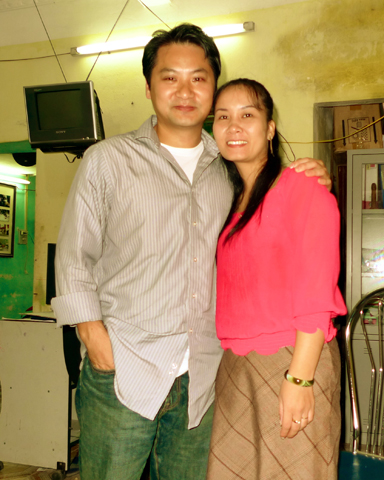
Don Nguyen, left, and Pham Thi Hue (Dau Nguyen)
As a playwright born in Vietnam, Don Nguyen saw dramatic possibilities in a New York Times story about an HIV-positive woman in Haiphong, a large port city near Hanoi, who started the country's first support group for infected women. He wasn't sure, though, that he could turn it into a play. Not only was it a heavy subject, but having lived in the U.S. since he was 3, he questioned his ability to capture the women's reality.
"I'm Vietnamese, but I grew up in Nebraska," he said. "They felt very foreign to me. I wasn't sure how I could write their voices. It was a fascinating subject but seemed daunting to take on."
Like most writers, he had a number of ideas rumbling around in his head. One nudging from the back of his mind was the ancient Vietnamese legend of the Trung sisters, who gave their lives in a fight against the Chinese army. Nguyen saw a creative challenge in combining the factual story with the myth, as both were about strong women fighting for liberation -- from a disease and its stigma, and from a threatening military.
The play that resulted, "Red Flamboyant," will have its world premiere April 24-May 16 at Calvary-St. George's, an Episcopal church in Manhattan, N.Y. The play is produced by Firebone Theatre, an off-off-Broadway company dedicated to producing plays "where the human meets the divine."
With casting set to begin, Nguyen, 42, and Firebone's artistic director, Chris Cragin-Day, 37, took time out on a cold January afternoon to talk about the production in Cragin-Day's office at The King's College, a Christian college in New York's financial district, where she is an assistant professor of English and theater.
"I love the feminist aspects of this story," Cragin-Day said. "I love these women who are just so powerful, not in a social sense but in a soul sense."
The real-life inspiration for the main character, Mrs. Hue, is Pham Thi Hue, who was featured in the 2006 Times story that Nguyen read. Although AIDS was widespread in Vietnam, many of those who had it were shunned by their families and fired if their employers found out. Most of the infected women had received the virus from husbands who were IV drug users.
Hue called her shelter Haiphong Red Flamboyant after a Vietnamese flower. Not only did she receive no government funding, the article said, but she had to endure bricks being thrown through her windows and a constant struggle to find money for food and medicine.
Nguyen hadn't known HIV/AIDS was so prevalent in Vietnam.
"It affected me, being Vietnamese, and that the country I was born in had such a huge problem. The stigma around it was shocking to me, and I wondered how I could get a germ of a play from that."
He began writing in 2008. To create a naturalistic play about Hue and all those dying of AIDS would be "an overwhelming experience for the audience," he said. "I had to find a less realistic way. The Trung sisters legend demanded more heightened reality. It dictated the voice of the play."
In short, the Trung sisters formed an army to seek revenge after the Chinese killed the husband of one of the sisters. The Chinese fought back and demanded the Vietnamese give up the sisters. They sacrificed themselves by jumping into a ravine.
Nguyen recognized a connection between Hue and the legendary sisters.
"She was a modern-day warrior who could be juxtaposed with the ancient female of Vietnam to make a great story."
But by 2010 and his "20th draft," he was frustrated. "I felt like I was writing from a distance with these people."
He decided to go to Vietnam to get a feel for the country and possibly meet Hue. Since he didn't speak Vietnamese, he asked his parents to go with him, and they readily agreed.
A cousin in the country found Hue for Nguyen and told her about the play he was writing. She agreed to a meeting. It was then that it hit him: Suppose the real Hue was nothing like the character he had created?
"It became really stressful. All I had had was one article to base her off of," Nguyen said.
His appointments with Hue kept getting canceled, meaning rescheduling flights a couple of times. After three weeks, it seemed ill-fated.
But when yet another meeting was scheduled, he went for it.
"It was really a good test of faith," he said.
And it paid off. With his father as interpreter, Nguyen talked to Hue for an hour. When he mentioned he was incorporating the sisters' legend, "her eyes lit up" and she told him it is the Vietnamese belief that "if you do something great, you are a sibling of the Trung sisters."
She told him to make it clear that she receives no government support. In that strong insistence, he recognized the character he had created was very much like the real Hue.
As Nguyen was leaving, Hue said something to him in Vietnamese. He smiled and nodded. In the taxi, his father told him she had said, "Don't forget about me."
And he hasn't. Ten percent of ticket sales from "Red Flamboyant" will go to support the real-life women through the Vietnam Relief Organization.
The four female characters and one male character will be played by Vietnamese actors if possible. If not, definitely by Asians. The actors will play instruments, since the play incorporates live and recorded music. The play also will feature puppetry, possibly water puppets, which are immensely popular in Vietnamese culture.
Some of the actors will have to fly, using single harness bungees for a more free-flowing choreography. These aerial feats alone would be challenging for a small off-off-Broadway company like Firebone, but Cragin-Day sees advantages in its size.
"We take risks," she said. "Companies like ours don't have much money at stake."
Still, the company bought extra insurance and hired Karen Fuhrman of Grounded Aerial, an expert in the field, to do the choreography.
"It gives us the freedom to experiment with the human body in flight," Cragin-Day said.
She believes the play will speak to many people, especially women.
"I feel like it's not just about Vietnamese women," she said. "This play captures that spiritual strength that is the legacy of women, and that's beautiful."
[Retta Blaney is an award-winning journalist and author of Working on the Inside: The Spiritual Life Through the Eyes of Actors.]




